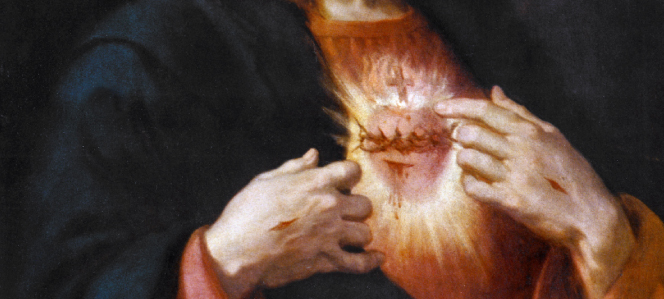Hanging on the wall of one of the confessionals at my parish is an image of the Sacred Heart of Jesus. The unknown artist has opted, as many have, for a soft Jesus, whose features are as bland and inoffensive as possible and whose heart is more of a glowing orb than anything remotely resembling flesh and blood. I know that the image is meant to communicate- that the Lord Jesus is accessible to the penitent and offers in response to even the most grievous of sins the possibility of another chance. This is not a Jesus prone to yelling “You did what?” It is a Jesus before which one would be able to deliver oneself with honesty without fear that what awaited such an admission would be blow to the face.
Comforting? Yes. It is also an image of Jesus that is, from an aesthetic perspective, utterly forgettable. The image lingers there, barely noticed. I think that I recall this depiction of Christ only because I am positioned beneath it with some measure of frequency. When I have mentioned to folks who frequently request the Sacrament of Penance that I would meet them in the confessional that has the image of the Sacred Heart of Jesus in it, they look at me as if they will need a map.
Images of the Sacred Heart of Jesus are enduring and ubiquitous in Catholic culture. The emphasis these images place on the approachability of Christ, even to the point of softening his features to effeminacy, is meant to communicate how human feelings and affections have been elevated through the Incarnation. Christ, who loves us, loves us in a way that we can appreciate and understand, and he makes himself available to us in our emotions. Christ can love us, and we can love him in return. Yet the traditional devotion to the Sacred Heart of Jesus has also stressed that the love of God in Christ is met, more often than not, by our refusal. The Heart of Jesus is not only radiant with love for us, but it is a wounded heart, encircled by thorns, and pierced- this is a Heart that we tried to kill, a love that we tried to extinguish.
But our attempts were frustrated by the willingness of Christ to love us even more. In this respect, the Sacred Heart of Jesus is itself an image of the totality of the Incarnation. The Incarnation is the revelation that God is love and that this love, resisting all our attempts to make it into something that serves our own egos, will always look in this world like Christ. What we did to this love, and continue to do to this love, is irrefutable evidence of how unlovable that we are- at least from our vantage point. However, seen from the vantage point of God, our failure to love him enflames his passion for us all the more. If, in the narrowness of our human hearts, we fail to understand why God’s love in Christ would resist the standards of justice that we all too readily impose, this might mean we actually appreciate how mysterious God’s love actually is.
God does not love us as we are accustomed to love each other. God does not love us because we deserve it or because we have earned it or because we have something that God needs that he lacks in his own nature. Instead, God is love. The Sacred Heart of Jesus is trying to make this point visually as its verbal expression seems at times harder to understand. Understanding all this is one thing. Accepting it is another.
The temptation to try to make God love as we love is particularly acute. Especially given that if God loved us on our terms it would also mean that he would be just as inclined to hate on our terms as well. It is hard to consider that humanity’s refusal of God, which is manifested in the cross, might be interpreted as the punishment we impose on God for not loving on our terms. That God in Christ transforms the punishment we impose on him into the means to love us even more makes its grace all the more difficult to fathom. But we must accept it, and for the saints such acceptance is irresistible. For the sinner such grace is a total surprise, and it is hard not to believe that there is some kind of catch. There isn’t a catch, even if we find that hard to believe.
That image of the Sacred Heart in the confessional has presided over more confessions than many priests will hear in a lifetime. Its presence has, for the most part, been unseen. However, how many penitents have caught a glimpse, if only for a moment, finding in it a quiet, gentle reassurance that in all that I have done and failed to do, in all of my refusals and failures to love, God is love, and in his Sacred Heart, he still loves me.
